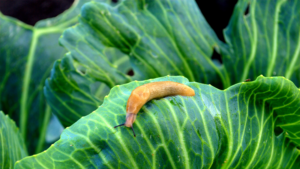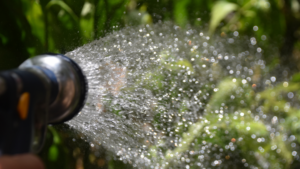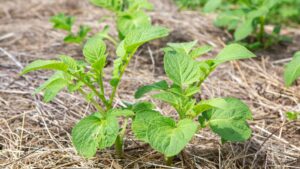.
Finally, we can wave those night frosts goodbye and enjoy the sun and warmth that May brings. All the veggies we’ve sown or planted out already get a boost and suddenly the earth is green again. With all the happiness it brings, there are also some tasks for us gardeners to make sure our green babies get on well. Let’s see what garden tasks wait for us in May.
#1 Protect your seedlings from snails and slugs

Are there any pest more dreaded than snails and slugs? I don’t think so. They are practically everywhere and, especially in spring, treat our gardens like all-you-can-eat buffets. The seedlings that just start looking out of the soil as well as the young plants we’ve put outside: all of that is a feast to slugs and snails and somehow they manage to tell all their friends and families about it. While I’m all for sharing with those who have less, slugs and snails don’t fall into that category, however, so there’s no need to have a bad conscious. If we want to harvest those veggies we nursed and nurtured all those months, we must make sure that snails and slugs won’t get near them!
A good way to keep those little suckers off our seedlings is to put snail collars around them which they can’t overcome. Or you get out in the wee hours of the morning or in the evening with a bucket and collect them. Choose your way, but I prefer the collars.
#2 Protect cabbage and leeks from pests
If you haven’t done so already, protect your cabbages and leeks with a protective net against pests like the cabbage white butterfly and the leek fly. Most often, you can buy protective nets as a set with half-arches that you can stick across the vegetables and put the net on top. That way, our plants have plenty of room to grow while being safe from pests. Just make sure that you fix the net thoroughly into the ground.
By the way, celery is a good companion for cabbage. In the unlikely event that a cabbage fly finds its way under the net, it may find itself repelled by the celery smell.
#3 Sowing and planting outdoors
Finally, as the last night frosts are history, we can sow and plant all the sensitive veggies we like so much. Beans, tomatoes, zucchini, corn, everything can now get outside! For a comprehensive list of vegetables you can sow and plant outdoors in May, read on here.
#4 Keep watering

The seeds, as well as our freshly transplanted seedlings, need water until they’ve formed a healthy root network. As it can be quite dry in spring, especially in May, make sure that you keep your plants and seeds moist enough to sprout.
#5 Harden off seedlings

All the vegetables we have seed-started indoors during the last weeks can finally be planted outdoors in May. Before we expose our seedlings to outdoor conditions, however, we must harden them off so that they won’t get a shock when they get from that cosy, protected atmosphere to the outside garden where temperature differences between night and day are higher and the wind can blow harshly.
To harden off our seedlings, we put them outside for a few hours per day, prolonging the time with each day. After about a week, our seedlings are ready to be planted outside.
If you want to know which vegetables you can plant outdoors now, read on here.
#6 Fertilising

Like a bunch of ravenous teenagers, our vegetables need food or rather: fertiliser. After planting our seedlings outdoors, they’ll be grateful for a healthy dose of organic liquid fertiliser to push their growth.
Did you know, by the way, that you can make a great fertiliser out of stinging nettle? Just cut it off, put it in a bucket and fill it up with water. Let the brew sit for 3 – 4 weeks (warning: it stinks!), take out the stinging nettles, and then you’ve made a nitrogen-rich fertiliser for nought! Now add this liquid manure to your water at a ratio of about 1:20 and fertilise your plants, especially the heavy-feeders, with it.
#7 Fertilise and mulch berry shrubs
Your berry shrubs, like raspberries, gooseberries, currants, blackberries and so an, need food as well. They can also profit from a healthy dose of that liquid manure from stinging nettles I mentioned above. Additionally, you should cover the soil under the bushes and shrubs now with mulch.
#8 Mulch

When your plants are about 10 – 15 cm (4 – 6 inches) high, you can add mulch to your patches. Either use (dry!) grass clippings, (old) hay, straw or leaves. Also good mulch material are wood chips that have the additional advantage of being avoided by snails and slugs.
#9 Break out the first blossom on your peppers
Check your peppers and chilis for the first blossom they produce and – brutal as it may sound- break it out. In doing so, you induce the plants to produce more flowers, which will eventually turn into fruit. If you let the first blossom stay on the plant, it would form no or only few additional flowers and your harvest would be very small.
#10 Gain your own seeds
Are there still some last year’s vegetables in your garden? Don’t rip them out. Instead, let them blossom and build seeds that you can gain for next year. They not only usually produce more sturdy plants, but they also make us independent from seed companies and let us save heirloom plants.
#11 Thinning seedlings
If you – like me – often sow vegetables like, for example, beetroots, too tight, you can now thin them out. Carefully remove seedlings that are to close to each other and plant them in gaps or even into a separate row. That way, they get enough space for them to become large and sturdy.
As May unfolds with its warm sunshine and gentle rains, your garden is ready to truly come alive. Now’s the perfect time to get your hands dirty planting those summer vegetables, while keeping an eye out for unwanted pests that enjoy the warmer weather too. Remember to water consistently as temperatures rise, add a fresh layer of mulch to retain moisture, and feed your plants enough but not too much. With just a few hours of care each week this month, you’ll be rewarded with a thriving garden that will provide beauty and bounty throughout the summer. Happy gardening!
Can’t get enough of gardening? These articles may also interest you:
Natural fertiliser from plants
Beginner’s Guide to Composting: How to make compost in 8 easy steps
23 Common Vegetable Gardening Mistakes (And How to Fix Them!)


0 Comments